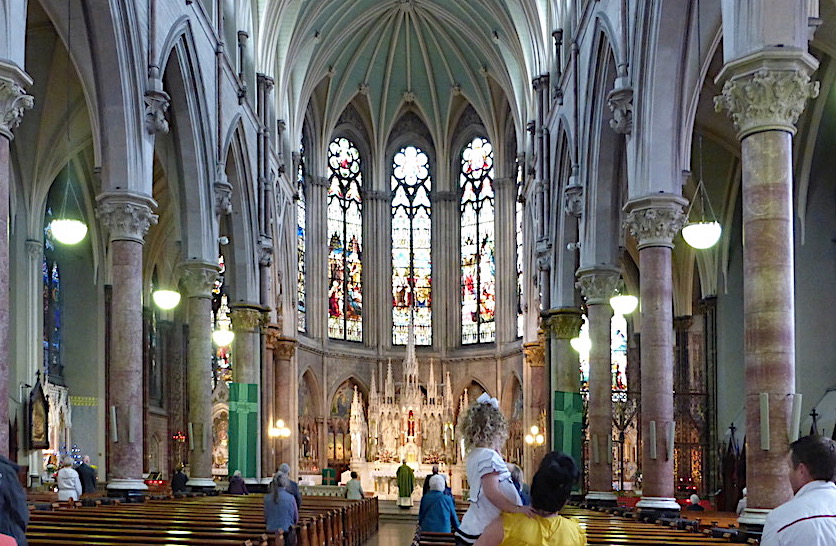


St. John the Baptist and St Augustine Church, Dublin, by Edward Welby Pugin (1834-1875) and George Coppinger Ashlin (1837-1921). The church was built largely from 1862-1874, when the nave and tower were completed, but the apse, which was by William Hague (1840-1899), was not completed until 1895, and the side chapels were added by Ashlin & Coleman in 1899. Materials: red sandstone and granite, with distinctive pitched copper roofing. The church is located on Thomas Street, on the corner of John's Lane, and familiarly known as John's Lane Church. At 223' high (see the church's own "History"), the "unusual chisel-shaped spire" is the tallest in Dublin, making it a city landmark (see the Casey 627). The bell-tower is decorated with the figures of the twelve apostles by James Pearce (Costello 48). [Click to enlarge the images above, as well as those that follow].



Left to right: (a) The welcoming figure of Jesus over the west entrance, with the text from St Matthew, 11, 28: "Venite ad me omnes qui laboratis et onerati estis et ego reficiam vos" or, translated from the Latin: "Come unto me all ye that labour and are heavy laden, and I will give you rest." (b) One of the flanking doors, also with beautiful carvings on the arches. (c) Ironwork on the door itself.
Built on the rather narrow site of an earlier "monastery of Crossed Friars under the Rule of St. Augustine" ("History"), this church still catches the eye from nearby, at street level, because of its very tall pointed entrance portal. The capitals and arches over the doors are very richly and finely carved, the figure of Jesus over the main entrance having been produced by the firm of Earley & Powell (according to the National Inventory). The ironwork on the doors themselves is intricately wrought. All in all, as Christine Casey says, "in external form" this is "undoubtedly the most original Victorian Gothic church in Dublin" (627).
Interior



Left to right: (a) At the entrance, "Tolle | Lege" in Latin, or "Take | Read" in English, refers to the instruction followed by St Augustine, who took up the Bible on hearing a child call out these words, and read the passage in St. Paul's Letter to the Romans that changed the entire course of his life. (b) Looking towards the chancel. (c) A wider view.
The church is equally impressive inside, with its "tall, profusely decorated French-style interior" (Casey 58), its red Cork marble columns and its apsidal chancel — this is the part that took so long to complete. It also has very beautiful stained glass windows. The great windows on the west front and in the apse are both by Mayers of Munich, and there are three windows from the renowned Harry Clarke studio as well. Not to be overlooked are its rich mosaics — and impossible to overlook, for it is the focus of the interior, is the glowing white Carrara marble altar with its "wonderfully pinnacled reredos," by Edmund Sharp (Casey 62).


Left: The remarkable reredos carved by Edmund Sharp. Right: The apse windows, not seen clearly, unfortunately. But the figures in the central window are the church's patrons, St Augustine and St John.
Photographs 2009 and 2017 and text 2018 by Jacqueline Banerjee. You may use these images without prior permission for any scholarly or educational purpose as long as you (1) credit the photographer and (2) link your document to this URL in a web document or cite the Victorian Web in a print one. [Click on the images to enlarge them.]
Bibliography
Casey, Christine. Dublin: The City within the Grand and Royal Canals and Circular Road. New Haven and London: Yale University Press, 2005.
"Church of St Augustine and St John." National Inventory of Architectural Heritage. Web. 16 August 2018.
Costello, Peter. Dublin Churches. Dublin: Gill and Macmillan, 1989.
"History" (on the church website). Web. 16 August 2018.
"John's Lane Church, Dublin: Stained Glass Windows" (on the church website) and, for some wonderful close-ups of the windows "A Poem in Stone" on YouTube. Web. 16 August 2018.
"The Simple Faith of St Augsutine" (on the church website). Web. 16 August 2018.
"William Hague (1840-1899)." Archiseek. Web. 16 August 2018.
Last modified 16 August 2018